Solar Energy Market Size
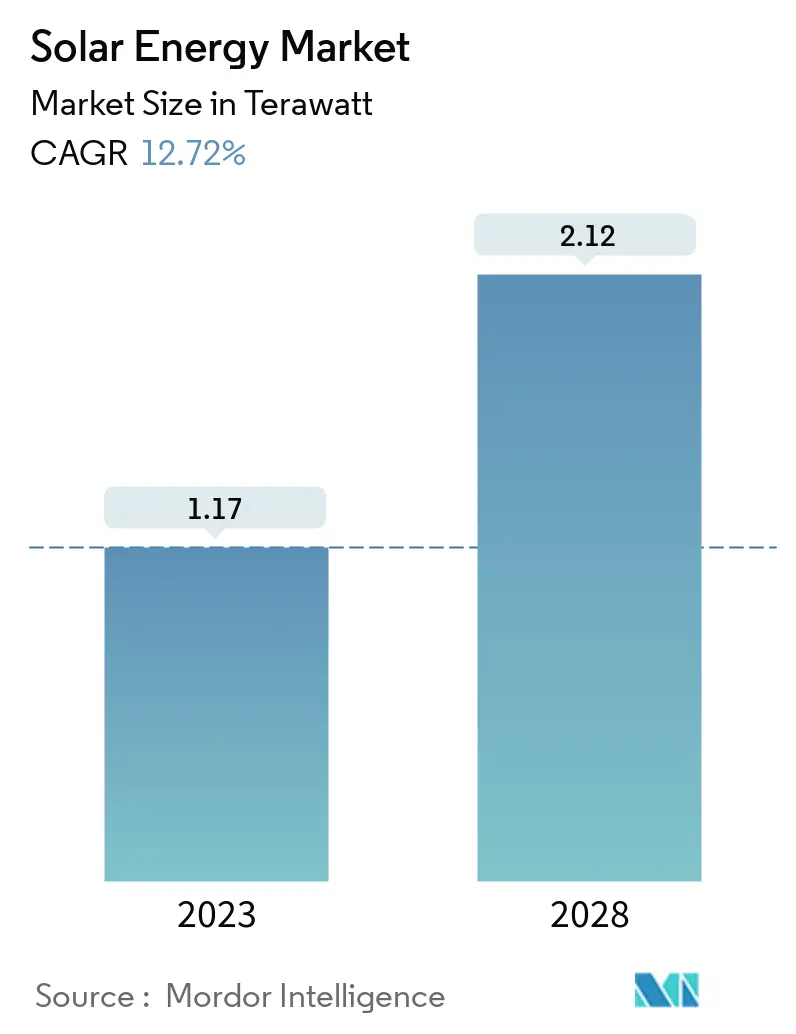
| Study Period | 2019 - 2028 |
| Market Volume (2023) | 1.17 terawatt |
| Market Volume (2028) | 2.12 terawatt |
| CAGR (2023 - 2028) | 12.72 % |
| Fastest Growing Market | Asia-Pacific |
| Largest Market | Asia-Pacific |
Major Players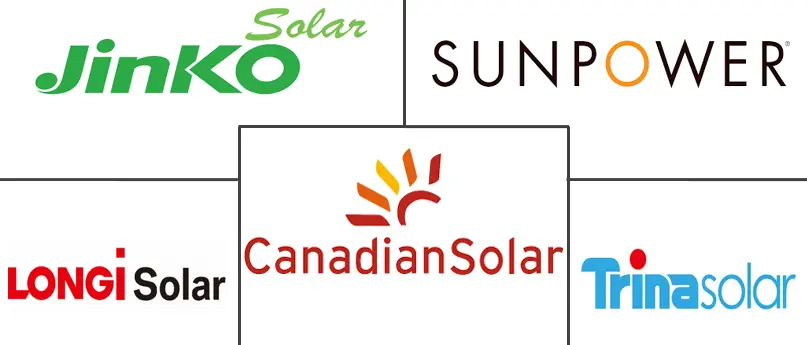
*Disclaimer: Major Players sorted in no particular order |
Need a report that reflects how COVID-19 has impacted this market and its growth?
Solar Energy Market Analysis
The Solar Energy Market size is expected to grow from 1.17 terawatt in 2023 to 2.12 Terawatt by 2028, at a CAGR of 12.72% during the forecast period (2023-2028).
- Over the medium term, favorable government policies and increasing adoption of solar PV systems, with the declining price of solar panels and installation cost, are likely to support the global solar energy market growth during the forecast period
- On the other hand, factors such as rising adoption of alternate clean power sources, such as gas-fired power plants, onshore and offshore wind projects are likely to hinder the market growth during the study period.
- Nevertheless, an increase in off-grid solar utilization due to the decreasing cost of solar PV equipment and integration with energy storage systems are expected to create several opportunities for the market in the future.
- Asia-Pacific region has dominated the solar energy market in the past few years and is expected to be the largest and fastest-growing region in the solar energy market during the forecast period. Due to its increasing solar installations.
Solar Energy Market Trends
Solar Photovoltaic (PV) Expected to Dominate the Market
- Solar PV systems convert sunlight directly into electricity using solar panels made up of semiconductor materials, typically silicon. When sunlight strikes the solar cells, it excites electrons, generating a flow of direct current (DC) electricity. This DC electricity is converted into alternating current (AC) using an inverter in homes, businesses, and the electrical grid.
- The cost of solar PV systems has declined rapidly over the past decade. This cost reduction is driven by technological advancements, economies of scale, and improved manufacturing processes. As a result, solar PV has become increasingly cost-competitive with conventional energy sources, making it more attractive for widespread adoption.
- Additionally, the global electricity demand is continuously increasing due to population growth, urbanization, and the electrification of various sectors, including transportation. Solar PV systems offer a scalable and decentralized solution to meet this growing energy demand, particularly in regions with limited or unreliable grid infrastructure.
- According to International Renewable Energy Agency the global solar photovoltaics installed capacity increased by more than 22% between 2022 and 2021 compared to 2% for concentrated solar power systems. Signifying the increased adaption of solar photovolatics over concentrated solar power systems.
- Moreover, governments worldwide have introduced supportive policies and financial incentives to promote solar PV installations. These measures include feed-in tariffs, tax credits, grants, and net metering programs. Such policies encourage the adoption of solar PV systems by reducing upfront costs, improving investment returns, and facilitating grid integration.
- For instance, Australia has set a goal of generating 82% of its electricity through renewable sources like solar pv and wind by 2030, and solar pv is expected to be a significant contributor in achieving this target.
- For instance, in November 2022, X-Elio unveiled its intentions to construct a solar photovoltaics farm with a capacity of 300 MW near Wagga Wagga, New South Wales. Additionally, X-Elio has initiated the development of two other solar photovoltaics farms, namely the Forest Glen Solar Farm, with a capacity of 120 MW in New South Wales, and the WunghnuSolar Farm with a capacity of 80 MW in Victoria. These projects form part of X-Elio's extensive portfolio, comprising more than 500 MW of renewable energy projects currently under development in Australia.
- Therefore, based on the abovementioned factors, the utility sector is expected to dominate the solar energy market during the forecast period.
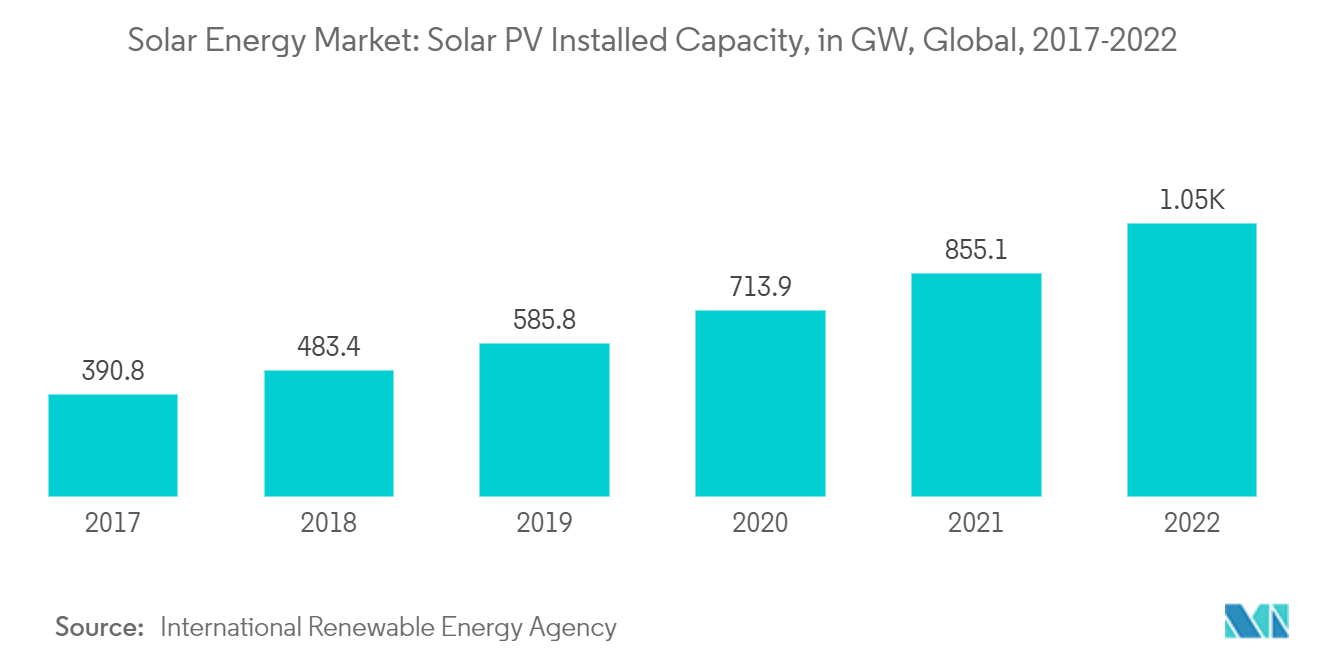
Asia-Pacific Expected to Dominate the Market
- Many countries in the Asia-Pacific region, such as China, India, and Japan, have implemented ambitious renewable energy targets and supportive policies to encourage solar energy adoption. These policies include feed-in tariffs, renewable portfolio standards, and subsidies for solar installations. Strong government support and stable policy frameworks have created a conducive environment for the region's solar energy market growth.
- For instance, according to the International Renewable Energy Agency, the total solar energy installed capacity between 2021 and 2022 grew by more than 110 GW. In 2021 the total installed capacity was around 485 GW, whereas in 2022, it reached 597 GW, with China and India holding major installed capacity.
- Furthermore, the Asia-Pacific countries have a rapidly growing population and expanding economies, leading to an increasing demand for electricity. Solar energy offers a scalable and sustainable solution to this growing energy demand. As a result, there is a strong market potential for solar energy deployment in the region.
- Moreover, several countries in the Asia-Pacific region have undertaken ambitious large-scale solar energy projects. For instance, China has been a leader in utility-scale solar installations, with extensive solar farms and solar parks. These large-scale projects have boosted the cumulative solar capacity in the region and positioned it as a dominant player in the global solar market.
- In March 2022, Alibaba Group's logistics arm Cainiao Network started to use distributed solar power generated by rooftop solar panels installed on its bonded warehouses in China to power its operations. The company had installed the PV power generation systems on 100,000 square meters of warehouse rooftop, which can store 7.862 MW of energy, with an annual power output of over 8 million kilowatts hour, enough to power more than 3,000 homes. The power generated by the solar power system will be sufficient to power Cainiao's warehouse operations, and excess electricity will be diverted to the grid. Further, by 2023, Cainiao and its partners expect to install rooftop PV generation systems on Cainiao's bonded warehouses spanning a combined 500,000 square meters.
- Asia-Pacific countries, particularly China, have also emerged as major manufacturing hubs for solar PV components and systems. The region benefits from economies of scale, efficient supply chains, and competitive production costs, significantly reducing the overall cost of solar energy systems. This cost advantage has contributed to the dominance of the Asia-Pacific region in the global solar energy market.
- Therefore, the Asia-Pacific as mentioned above region is expected to dominate the solar energy market during the forecasted period.
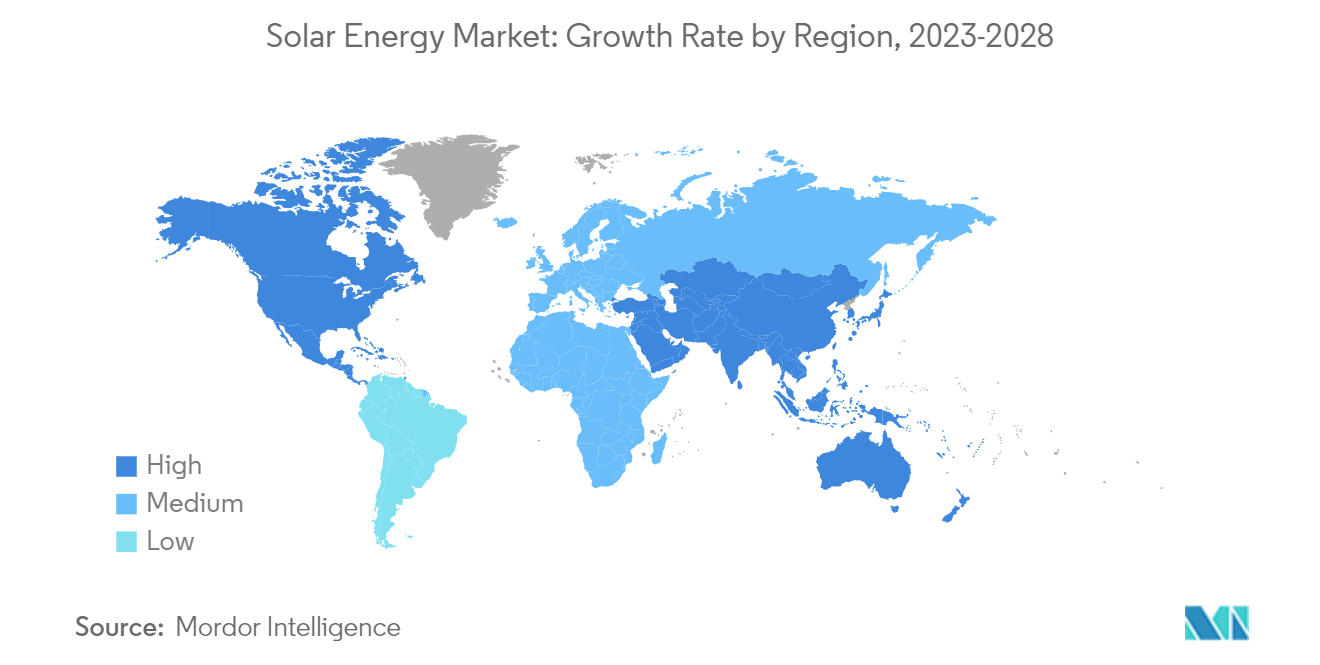
Solar Energy Industry Overview
The Solar Energy Market is fragmented. Some of the key players in the market (in no particular order) include Canadian Solar Inc., JinkoSolar Holding Co. Ltd, Trina Solar Co. Ltd, SunPower Corporation, and LONGi Green Energy Technology Co. Ltd. among others.
Solar Energy Market Leaders
SunPower Corporation
LONGi Green Energy Technology Co. Ltd
Trina Solar Ltd
Canadian Solar Inc.
JinkoSolar Holdings Co. Ltd
*Disclaimer: Major Players sorted in no particular order
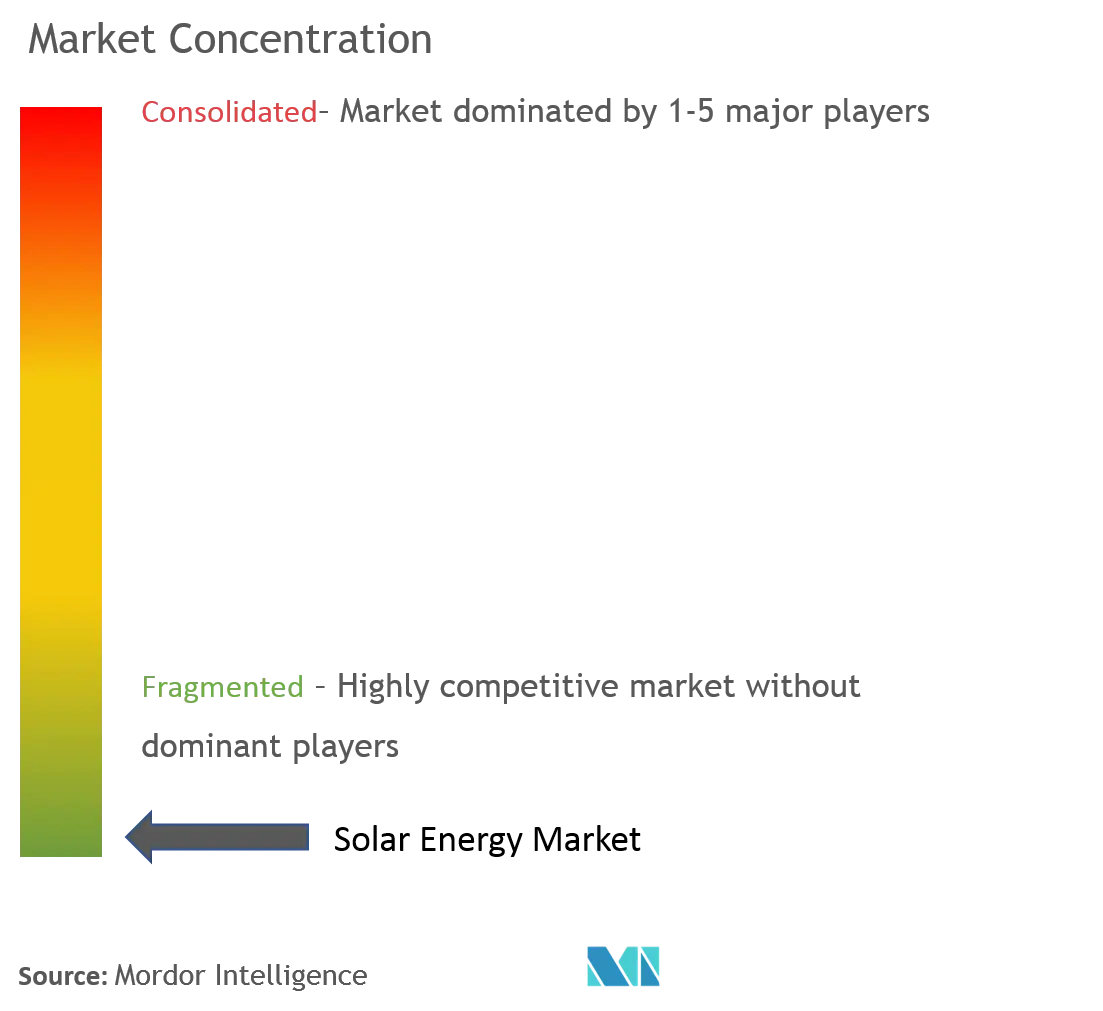
Solar Energy Market News
- September 2022: Amazon India announced its first set of utility-scale renewable energy projects in India – three solar farms in Rajasthan, totaling a combined clean energy capacity of 420 megawatts (MW). These include a 210 MW project to be developed by ReNew Power, a 100MW project by Amp Energy India, and a 110MW project to be developed by Brookfield Renewable.
- March 2022: California Department of Water Resources, utility company Turlock Irrigation District (TID), Marin County, California-based water and energy project developer Solar AquaGrid, and University of California partnered on a pilot project named Project Nexus.
- May 2022: NJR Clean Energy Ventures (CEV) started construction on an 8.9-MW floating solar installation in Millburn, New Jersey, expected to be the largest floating array in the United States. The project uses a floating racking system, 16,510 solar panels ware likely to be installed on a reservoir at the New Jersey American Water Canoe Brook Water Treatment Plant. The clean power generated by the array was expected to provide approximately 95% of the facility’s annual power needs through a power purchase agreement with CEV.
Solar Energy Market Report - Table of Contents
1. INTRODUCTION
1.1 Scope of the Study
1.2 Market Definition
1.3 Study Assumptions
2. EXECUTIVE SUMMARY
3. RESEARCH METHODOLOGY
4. MARKET OVERVIEW
4.1 Introduction
4.2 Global Renewable Energy Mix, 2022
4.3 Solar Energy Installed Capacity and Forecast in GW, till 2028
4.4 Recent Trends and Developments
4.5 Government Policies and Regulations
4.6 Market Dynamics
4.6.1 Drivers
4.6.1.1 Government Incentives and Policies
4.6.1.2 Energy Security
4.6.2 Restraints
4.6.2.1 Competition from Other Energy Sources
4.7 Supply Chain Analysis
4.8 Industry Attractiveness - Porter's Five Forces Analysis
4.8.1 Bargaining Power of Suppliers
4.8.2 Bargaining Power of Consumers
4.8.3 Threat of New Entrants
4.8.4 Threat of Substitute Products and Services
4.8.5 Intensity of Competitive Rivalry
5. MARKET SEGEMENTATION
5.1 Technology
5.1.1 Solar Photovoltaic (PV)
5.1.1.1 Overview
5.1.1.2 Solar Photovoltaic (PV) Installed Capacity and Forecast, in GW, till 2028
5.1.1.3 Annual Solar PV Shipments, in GW, till 2022
5.1.1.4 Share of Solar PV Shipments (%), by Technology, 2022
5.1.1.5 Average Selling Price of Solar PV Module, in USD/W, till 2022
5.1.1.6 Key Projects Information
5.1.2 Concentrated Solar Power (CSP)
5.1.2.1 Overview
5.1.2.2 Concentrated Solar Power (CSP) Installed Capacity and Forecast, in GW, till 2028
5.1.2.3 Solar Thermal Capacity in Operation, in GW, till 2022
5.1.2.4 Solar Thermal Installed Capacity Share (%), by Collector Type, 2022
5.1.2.5 Key Projects Information
5.2 Geography Regional Market Analysis {Market Size and Demand Forecast till 2028 (for regions only)}
5.2.1 North America
5.2.1.1 United States
5.2.1.2 Mexico
5.2.2 Europe
5.2.2.1 Germany
5.2.2.2 Spain
5.2.2.3 Italy
5.2.2.4 United Kingdom
5.2.2.5 Rest of Europe
5.2.3 Asia-Pacific
5.2.3.1 China
5.2.3.2 India
5.2.3.3 Japan
5.2.3.4 Australia
5.2.3.5 Rest of Asia-Pacific
5.2.4 South America
5.2.4.1 Brazil
5.2.4.2 Argentina
5.2.4.3 Chile
5.2.4.4 Rest of South America
5.2.5 Middle-East and Africa
5.2.5.1 Saudi Arabia
5.2.5.2 United Arab Emirates
5.2.5.3 Egypt
5.2.5.4 Nigeria
5.2.5.5 South Africa
5.2.5.6 Middle-East and Africa
6. COMPETITIVE LANDSCAPE
6.1 Mergers and Acquisitions, Joint Ventures, Collaborations, and Agreements
6.2 Strategies Adopted by Leading Players
6.3 Company Profiles
6.3.1 Canadian Solar Inc.
6.3.2 JinkoSolar Holding Co. Ltd.
6.3.3 Trina Solar Co. Ltd.
6.3.4 SunPower Corporation
6.3.5 LONGi Green Energy Technology Co. Ltd.
6.3.6 First Solar Inc.
6.3.7 JA Solar Holding
6.3.8 Abengoa SA
6.3.9 Acciona SA
6.3.10 Brightsource Energy Inc.
6.3.11 Engie SA
6.3.12 NextEra Energy Inc.
6.3.13 ACWA Power
6.3.14 Sharp Corporation
6.3.15 REC Solar Holdings AS
6.3.16 Hanwha Corporation
- *List Not Exhaustive
7. MARKET OPPORTUNITIES AND FUTURE TRENDS
7.1 Energy Storage Integration
Solar Energy Industry Segmentation
Solar energy refers to the energy obtained from the Sun's radiation. It is a renewable and abundant source of energy that can be harnessed and converted into usable forms such as electricity and heat. The Sun emits electromagnetic radiation, including visible light, infrared, and ultraviolet (UV). Solar energy technologies capture and convert this radiation into usable energy for various applications.
The Solar Energy Market is segmented by technology and geography (North America, Europe, Asia-Pacific, South America, and Middle-East and Africa). By technology the market is segmented into Solar Photovoltaic (PV) and Concentrated Solar Power (CSP). The report also covers the market size and forecasts for the solar energy market across major regions. For each segment, the market sizing and forecasts have been done based on installed capacity in GW (Giga-Watt).
Solar Energy Market Research FAQs
How big is the Solar Energy Market?
The Solar Energy Market size is expected to reach 1.17 terawatt in 2023 and grow at a CAGR of 12.72% to reach 2.12 terawatt by 2028.
What is the current Solar Energy Market size?
In 2023, the Solar Energy Market size is expected to reach 1.17 terawatt.
Who are the key players in Solar Energy Market?
SunPower Corporation, LONGi Green Energy Technology Co. Ltd, Trina Solar Ltd, Canadian Solar Inc. and JinkoSolar Holdings Co. Ltd are the major companies operating in the Solar Energy Market.
Which is the fastest growing region in Solar Energy Market?
Asia-Pacific is estimated to grow at the highest CAGR over the forecast period (2023-2028).
Which region has the biggest share in Solar Energy Market?
In 2023, the Asia-Pacific accounts for the largest market share in the Solar Energy Market.
Solar Energy Industry Report
Statistics for the 2023 Solar Energy market share, size and revenue growth rate, created by Mordor Intelligence™ Industry Reports. Solar Energy analysis includes a market forecast outlook to 2028 and historical overview. Get a sample of this industry analysis as a free report PDF download.
